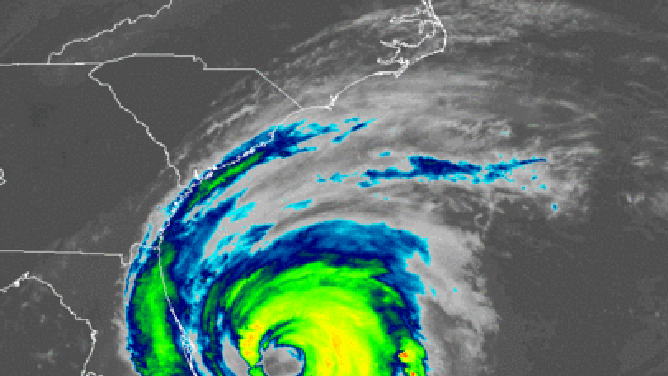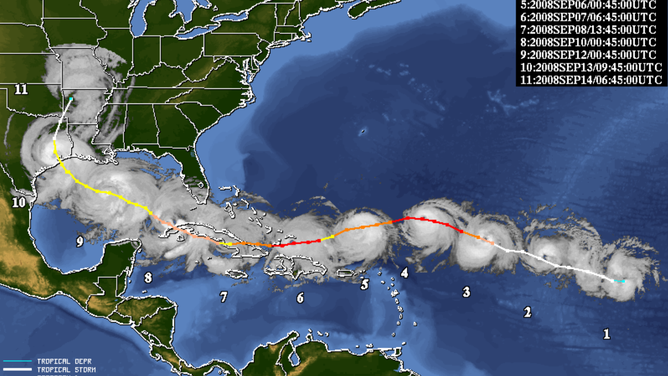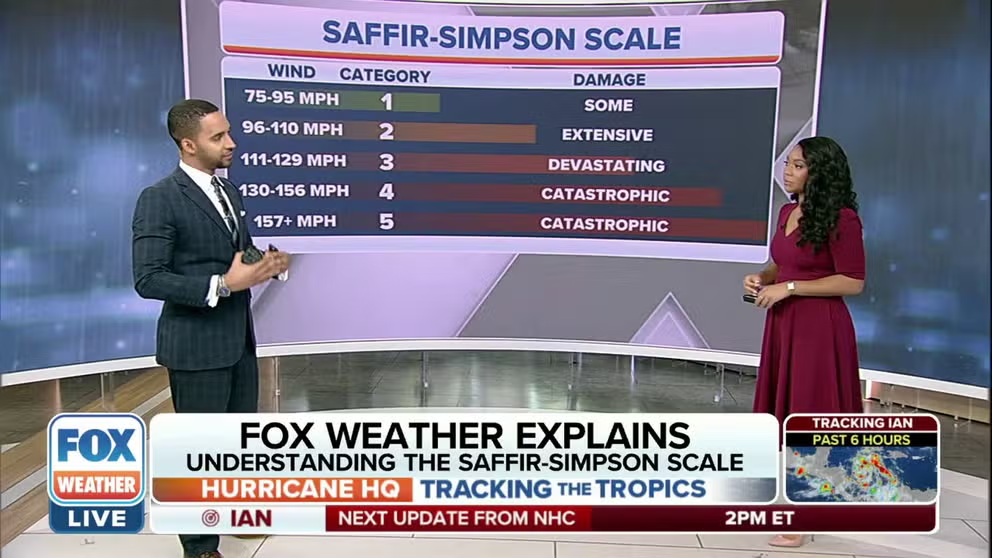What is a Category 2 hurricane?
According to NOAA, well-constructed homes can see roof damage with significant damage to the tree canopy. Shallowly rooted trees can be snapped or uprooted. Power outages can last several days to a week or longer, and a sea level rise of 6-8 feet can be expected. Hurricanes Dorian and Ike were Category 2 cyclones when they made landfall in the U.S.
FOX Forecast Center explains the Saffir-Simpson Scale
FOX Weather meteorologists Michael Estime and Kiyana Lews explain the Saffir-Simpson Scale that measures a hurricane’s intensity.
A hurricane with maximum sustained winds of 96-110 mph is considered to be a Category 2 cyclone on the Saffir-Simpson Hurricane Wind Scale.
A Category 2 storm is stronger than a Category 1 and is just one status below what is considered to be a major hurricane.
The wind scale does not take into account flooding, erosion, tornadoes or storm surge, which can be hazardous during a Category 2 hurricane.
According to NOAA, damage is considered to be extensive, and even well-constructed homes can sustain major roof and siding damage.
Due to extensive tree damage, power outages can last several days to weeks.
Along the coast, a Category 2 hurricane can produce a storm surge from 6 to 8 feet. This rise in water level can cause extreme erosion and flood low-lying areas.

Category 2 hurricane explainer
(FOX Weather)
7 FACTS TO KNOW ABOUT HURRICANES
Prior to the arrival of a storm, widespread evacuations are issued by local authorities for low-lying areas, residents with medical needs and mobile homes.
After the passage of a Category 2 hurricane, clean-up of debris may take weeks.
Once sustained winds are greater than 110 mph, a hurricane is considered to be a Category 3 on the Saffir-Simpson scale.
A Category 3 storm is capable of producing devastating damage and is considered to be a major hurricane.
Hurricanes of Category 2 strength typically form between August 11 and November 15.
Memorable Category 2 strikes on the U.S.
Hurricane Sally (110 mph) 2020
- Location: Gulf Shores, Alabama
- U.S. damage: $7.3 billion
- Despite a direct strike along the Gulf Coast and nine deaths connected to the storm, the name Sally has not been retired from its rotation. The storm was crawling at less than 5 mph when it inundated southern Alabama and the Florida Panhandle with a surge and inland flooding.

Hurricane Sally GOES EAST satellite imagery on September 14, 2020
(NOAA)
Hurricane Dorian (100 mph) - 2019
- Location: Cape Hatteras, North Carolina
- U.S. damage: $1.6 billion
- Hurricane Dorian was the strongest hurricane to ever make landfall in the Bahamas, but due to weakening, only impacted the U.S. at Category 2 strength. Dorian caused significant problems along nearly the entire Eastern Seaboard but only made a direct landfall in North Carolina. Since the destruction in 2019, the World Meteorological Organization has since retired the name of Dorian from the Atlantic basin’s naming lists.

Satellite loop of Hurricane Dorian moving north from the Bahamas and impacting eastern South and North Carolina.
(NOAA)
Hurricane Ike (110 mph) – 2008
- Location: Galveston Island, Texas
- U.S. damage: $30 billion
- While Hurricane Ike peaked at Category 4 strength while over the southwest Atlantic, its wind energy was only at Category 2 strength when it made landfall outside of Houston. Ike maintained its organization through the Ohio Valley, which caused millions of power losses over a wide swath of North America. NOAA reported more than 100 people were killed during the storm. Similar to Dorian, the name Ike will never be used again.

Hurricane Ike past track
(NOAA)
